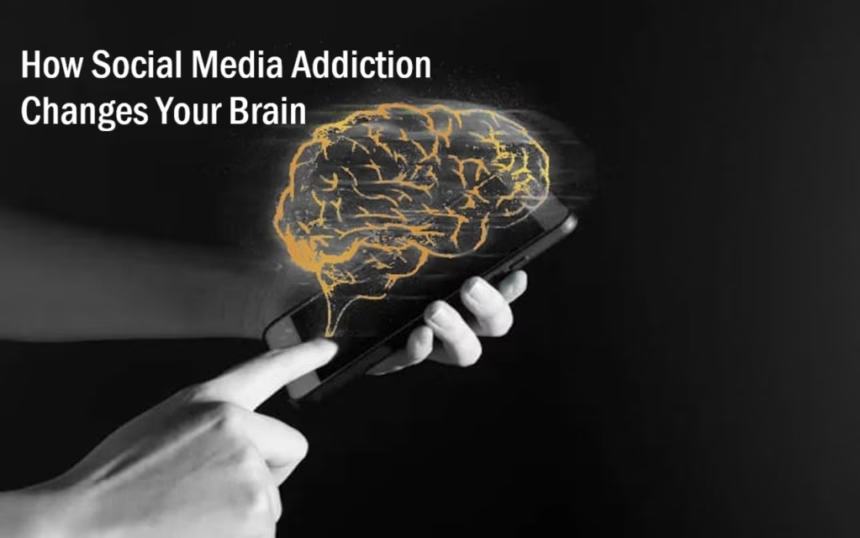Constant pings, fresh posts, and endless feeds pull hard on attention. The science is clear: heavy social use can change how the brain handles reward, focus, sleep, and mood. Social media addiction means compulsive use with cravings, loss of control, and harm to daily life.
Here is the big picture. Likes and streaks tap into the brain’s reward system, which uses dopamine to tag what matters. Fast, unpredictable rewards train habits that are hard to stop. Constant switching between apps and alerts wears down the prefrontal cortex, the brain’s focus and control center. Sleep takes a hit, and mood often follows.
Surveys show most teens use social media several times a day, and many report screen time over seven hours. That much input has real effects. Still, the outlook is hopeful. Brains rewire with practice. The guide below shows how.
At the end, there is a simple 30‑day plan to reset habits without quitting cold turkey. It protects sleep, rebuilds attention, and adds steady, real-life rewards that last.
Dopamine and the Reward System: How Likes and Streaks Train the Brain
The brain has a reward pathway that helps it learn what to repeat. When something feels good or important, dopamine signals help tag the moment. Over time, the brain links cues with rewards. It starts to respond not only to the reward, but to the hint that one might be coming.
Social apps use features that fit this pattern. Notifications act like tiny bells. Pull-to-refresh and infinite scroll feel like opening a prize box. Short videos add novelty every few seconds. Streaks add a goal to chase, with a loss if a day is missed. The mix is powerful, especially for teens.
This setup does not mean social media works like hard drugs. It does mean the brain learns very fast from variable rewards. That learning can make stopping hard, even when someone wants to cut back.
Unpredictable rewards and dopamine spikes
Variable rewards are like mystery boxes. Sometimes a post is great, sometimes not. That unpredictability keeps users checking. Dopamine acts as a learning signal more than a pleasure bath. It spikes around cues and surprises, helping the brain remember what led to a payoff. Over time, the brain gets wired to chase the next surprise.
Tolerance and numbness over time
Large, frequent bursts can lead to smaller responses later. That is tolerance. It feels like needing more scrolling or more novelty to get the same spark. When the brain is tuned to fast hits, slower joys, like reading or a quiet walk, can feel flat for a while. With time away and steady habits, baseline pleasure can return.
Cues, triggers, and habit loops
Badges, sounds, and lock-screen previews act as cues that start habit loops. The loop is simple: cue, scroll, reward, repeat. One quick example: a phone buzzes during homework, a swipe to check a message, then a “while I’m here” scroll, and 20 minutes are gone. The loop strengthens each time it runs, unless cues are reduced and a new routine is built.
Why do children and teens face a higher risk?
The prefrontal cortex, the control center for planning and restraint, matures into the mid-20s. That means teens often feel strong pulls and have a harder time stopping mid-urge. Mood swings can be sharper, too. This is not a character flaw. It is development. Family device rules, school norms, and clear routines help create guardrails while control systems grow.
Attention, Memory, and Decision Making: What Constant Scrolling Does to Thinking
Heavy social use often means rapid switching between apps, alerts, and feeds. The prefrontal cortex handles focus and planning, but it can tire under nonstop switching. Studies link high use with attention problems and weaker decision skills. Some research reports a smaller gray matter volume in attention and control areas in heavy users, which are associations, not proof of harm. Sleep loss from late-night scrolling makes thinking worse the next day.
Shorter attention span and task switching costs
Switching tasks is not free. The brain pays a cost to stop one task and start another. Those costs add up, lowering deep focus. Picture trying to study while checking messages every few minutes. Each check breaks the thread. Single-task blocks protect attention. Even 25 minutes without interruptions makes a difference.
Working memory overload and weaker recall
Working memory is the brain’s scratchpad. It holds a few items for a short time. Nonstop input fills that space fast, leaving less room for problem-solving or learning. Simple supports help. Notes for ideas, timers for focus blocks, and quiet study slots keep the scratchpad clear for the task at hand.
Sleep loss makes thinking and mood worse.
Late-night scrolling delays sleep, and blue light tells the brain it is daytime. Signs show up the next day as brain fog, low energy, and more mistakes. Even one hour less sleep hurts attention and memory. A 60-minute wind-down with no scrolling helps. Charging the phone outside the bedroom helps even more.
Impulsivity and weaker self-control
When cues are constant, the control system tires. Heavy social use is linked with more snap choices and less planning. Think of clicking a link in class before thinking it through, or posting in anger, then feeling regret. Fewer cues and more structure allow better choices to show up.
Mental Health Effects: Anxiety, Depression, Sleep, and the Doomscrolling Loop
Daily social use over about three hours is linked with higher anxiety and depression risk, worse sleep, and more stress. The wording matters here. These are links, not proof that social media alone causes these outcomes. Still, patterns are strong, and they point to steps that help.
Doomscrolling feeds worry. Negative news and conflict keep the brain on alert. Social comparison can lower mood. Polished posts make real life look dull. For teens, risks like cyberbullying and pressure to join risky trends add more stress.
More time online, higher risk for mood problems
More daily use is tied to more anxiety and depression symptoms, especially in teens. Better sleep, clear time limits, and supportive friendships help lower risk. Parents and schools can set healthy norms, which makes it easier for everyone to follow the same rules.
Social comparison, FOMO, and loneliness
FOMO means fear of missing out. It grows when feeds show only the best moments. This can make real life feel less exciting. A simple shift helps. Follow accounts that teach, support, or inspire. Mute or unfollow accounts that trigger constant comparison.
Cyberbullying, risky trends, and stress
Negative interactions raise stress and fear. Pressure to join trends can push unsafe behaviour. Every platform offers reporting tools, plus block and mute features. Teens should bring trusted adults into the loop early, not after harm builds.
Red flags of addiction to watch for
- Cravings and urges to check, even during class, work, or meals
- Hiding or lying about use, or sneaking screen time at night
- Losing interest in hobbies, sports, or time with friends
- Falling grades or work problems
- Sleep loss, headaches, or eye strain
- Using more when sad, angry, or sick
- Failed cutbacks after making rules
If several signs stick around for weeks, it is time to seek help from a parent, counsellor, or clinician.
Reset and Recovery: A Simple 30-Day Plan to Rewire Habits and Protect the Brain
Brains change with use. That is neuroplasticity. Small, steady steps can retrain cues and rebuild attention. This 30-day plan reduces triggers, protects sleep, and adds healthy rewards that lift mood slowly and last.
Set dose limits and no-scroll zones that stick
- Aim for 60 to 90 minutes total per day, split into 2 or 3 sessions.
- Use app timers and stick to them. Set the phone to ask for a passcode after limits, and have someone else set it if needed.
- Create phone-free zones: dinner table, bathroom, and bedroom.
- Set a 12-hour overnight off window, like 8 p.m. to 8 a.m., to protect sleep.
Tame notifications and redesign the home screen
- Turn off badges, sounds, and lock-screen previews for social apps.
- Leave messages and calls on, but bundle notifications to arrive a few times a day.
- Move social apps into a hidden folder on the last screen.
- Try grayscale. Few colours make feeds less tempting and lower cue strength.
Swap scrolling with a brain-healthy reward.rds
- Replace time online with steady mood boosters: brisk walks, exercise, music, art, cooking, reading, or calling a friend.
- Tie new habits to existing anchors. For example, take a 15-minute walk after school or work, or read 10 pages after dinner.
- Track mood and sleep daily in a simple note. Look for patterns. If a habit helps, keep it.
Monotask and sleep routines for a calmer mind
- Use 25 to 50 minute focus blocks, with 5 to 10 minute breaks.
- Keep the phone in another room during work blocks. If that is not possible, put it in a bag or drawer.
- Star60-minute wind-down before sleep. Dim lights, stretch, journal, or read paper pages. No screens in bed.
- Use the 10-minute delay rule. When a craving hits, wait 10 minutes and do a quick breathing exercise. Most urges pass.
A simple 30-day roadmap
| Week | Focus | Actions to Practice |
|---|---|---|
| 1 | Remove cues | Turn off badges, move apps, grayscale, no phone at meals |
| 2 | Set limits | 2 to 3 sessions daily, app timers, 12-hour overnight off |
| 3 | Add rewards | Daily walk, one creative hobby, call a friend, track mood |
| 4 | Deepen routines | Focus blocks, phone in another room, 60-minute wind-down |
Progress rarely looks perfect. Expect slips. Look for trend lines instead. Fewer cues, shorter sessions, better sleep, and more real-life rewards usually lead to a calmer mood and better focus within a month.
Conclusion
- Heavy use trains dopamine around cues and fast rewards, and that can make stopping hard.
- Constant switching weakens attention, working memory, and planning, while sleep loss makes thinking worse.
- More daily time is linked with higher anxiety and depression risk, and doomscrolling and comparison can amplify stress.
- Teens face a higher risk because control systems are still growing, but simple guardrails help.
- The brain can heal. Steady habits rebuild focus, improve sleep, and lift mood.
Try one small change today, like turning off badges or starting a 60-minute wind-down. If symptoms stick around, reach out to a parent, counsellor, or clinician. The brain learns what it repeats. With practice, it can learn calmer, healthier patterns again.















